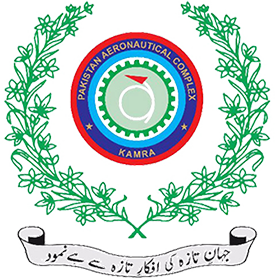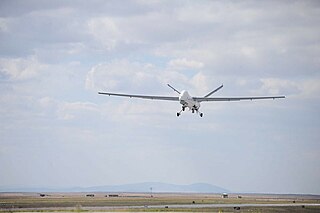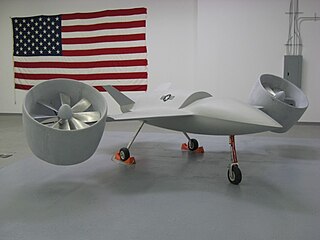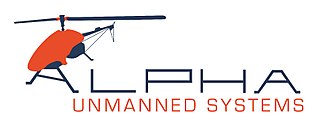
The AAI RQ-7 Shadow is an American unmanned aerial vehicle (UAV) used by the United States Army, Australian Army and Swedish Army for reconnaissance, surveillance, target acquisition and battle damage assessment. Launched from a trailer-mounted pneumatic catapult, it is recovered with the aid of arresting gear similar to jets on an aircraft carrier. Its gimbal-mounted, digitally stabilized, liquid nitrogen-cooled electro-optical/infrared (EO/IR) camera relays video in real time via a C-band line-of-sight data link to the ground control station (GCS).

Israel Aerospace Industries or IAI (תע"א) is Israel's prime aerospace and aviation manufacturer, producing aerial and astronautic systems for both military and civilian usage. It has 16,000 employees as of 2013. IAI is wholly owned by the government of Israel.

Robert C. Michelson is an American engineer and academic widely known for inventing the entomopter, a biologically inspired flapping-winged aerial robot, and for having established the International Aerial Robotics Competition. He has received degrees in electrical engineering from the Virginia Polytechnic Institute and the Georgia Institute of Technology. Michelson's professional career began at the U.S. Naval Research Laboratory where he worked on radar-based ocean surveillance systems. He later became a member of the research faculty at the Georgia Institute of Technology. At the Georgia Tech Research Institute (GTRI) he was involved in full-time research, directing over 30 major research programs.

The Boeing A160 Hummingbird is an unmanned aerial vehicle (UAV) helicopter. Its design incorporates many new technologies never before used in helicopters, allowing for greater endurance and altitude than any helicopter currently in operation.

The Pakistan Aeronautical Complex (PAC) is a Pakistani aerospace, defence, aviation contractor, and military corporation producing aerial systems for both military and civilian usage, situated in Kamra, Attock District.

The Elbit Hermes 450 is an Israeli medium size multi-payload unmanned aerial vehicle (UAV) designed for tactical long endurance missions. It has an endurance of over 20 hours, with a primary mission of reconnaissance, surveillance and communications relay.

Aeronautics Ltd. is an Israeli company specializing in the manufacturing of Unmanned Aerial Systems, commonly known as drones, for military uses. Since its establishment in 1997, the company's products have been sold to over 20 defense, military and homeland security customers in 15 countries. Its headquarters are in Yavne, Israel.
Integrated Dynamics is a private company in Pakistan that designs, manufactures and exports various types of unmanned aerial vehicles (UAV). ID also provides consultancy and turn-key project commissioning for UAV systems.

The TAI Anka is a family of unmanned aerial vehicles (UAV) developed by Turkish Aerospace Industries (TAI) for the requirements of the Turkish Armed Forces. Basic Anka-A is classified as a Medium Altitude Long Endurance (MALE) UAV. Envisioned in the early 2000s for tactical surveillance and reconnaissance missions, the Anka has now evolved into a modular platform with synthetic aperture radar, precise weapons and satellite communication. The drone is named after a phoenix-like mythological creature called Zümrüd-ü Anka

The AD-150 is a high-speed VTOL tilting ducted fan unmanned aerial vehicle that is being developed by American Dynamics Flight Systems as a future competitor for the United States Marine Corps' Tier III VUAS program as well as other current and future United States VTOL UAV programs.
The Association for Unmanned Vehicle Systems International, also known as AUVSI, is an international nonprofit organization dedicated to promoting and supporting the unmanned systems and robotics industry through communication, education and leadership.
Aeronautical Development Establishment is a laboratory of India's Defence Research and Development Organisation (DRDO). Located in Bangalore, its primary function is research and development in the field of military aviation.

The E1 Gavilán is an unmanned electrical-surveillance airplane of design and manufacturing by the Mexican firm Hydra Technologies of Mexico. The aircraft is a remotely controlled unmanned aerial vehicle.
Hydra Technologies is a Mexican firm dedicated to the design and development of unmanned aerial vehicles for surveillance operations and aircraft avionics. The company has one hundred employees and as of mid-2008 has two operational models, the S4 Ehécatl and the E1 Gavilán.

The Wasp III Small Unmanned Aircraft System is a Miniature UAV developed for United States Air Force special operations to provide a small, light-weight vehicle to provide beyond-line-of-sight situation awareness. The aircraft is equipped with two on-board cameras to provide real-time intelligence to its operators. It is also equipped with GPS and an Inertial Navigation System enabling it to operate autonomously from takeoff to recovery. It was designed by AeroVironment Inc. and was first added to the Air Force inventory in 2007. There are two Wasp variants: the traditional version that lands on land and a version that lands into the sea or fresh water. The Air Force accepted the Wasp AE in late May 2012, and the U.S. Marine Corps revealed in January 2013 that they had ordered the Wasp AE. The Wasp AE is designated as the RQ-12A.

The Arcturus T-20 unmanned aerial vehicle (UAV) is a medium range, fully composite aircraft capable of internal and external payloads. Launched from a portable catapult, it can be recovered with a shipboard landing system, or belly land on unimproved surfaces. The T-20 carries a retractable gimbal-mounted, digitally stabilized, electro-optical/infrared (EO/IR) camera that relays video in real time via a C-band LOS data link to the ground control station (GCS). Powered by a 4-stroke, fuel injected gasoline engine, the aircraft burns 2 lbs of fuel per hour at cruise. The T-20 does not require an airfield to operate and lands on dirt, grass, desert, or gravel roads. The internal payload bay (11"x11"x36") allows for sensor arrays to be pre-assembled on 'payload pallets' that attach from the bottom of the aircraft. The T-20 system includes three aircraft, ground control station, portable launcher, and support trailer for equipment and personnel. The airframe is entirely composite with complex wet wings tested to stresses of 10 G's.

The EADS Talarion is a twinjet Medium-altitude long-endurance unmanned aerial vehicle, designed by EADS, to meet future European military needs for aerial reconnaissance, military intelligence, and aerial surveillance. EADS has run a preliminary design review, and is awaiting orders. The source of the name is the Talaria—the winged sandals of the Greek Messenger God Hermes.
The IAI Ghost is a reconnaissance mini unmanned air vehicle developed in Israel by Israel Aircraft Industries. It is the second tandem-rotor UAV developed by IAI after IAI Panther.

Alpha Unmanned Systems is a privately owned Spanish company based in Madrid, dedicated to the design, development and production of small unmanned aerial vehicles (sUAVs). Additionally, the company provides integration of flight control systems and payloads for ISTAR missions and non-military tasks.
























